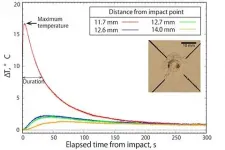(Press-News.org) EAST LANSING, Mich. - It can be easy to forget that the human skin is an organ. It's also the largest one and it's exposed, charged with keeping our inner biology safe from the perils of the outside world.
But Michigan State University's Sangbum Park is someone who never takes skin or its biological functions for granted. He's studying skin at the cellular level to better understand it and help us support it when it's fighting injury, infection or disease.
In the latest installment of that effort, Park, who works in IQ -- MSU's Institute for Quantitative Health Science & Engineering -- has helped reveal how the skin's immune cells organize themselves to ward off would-be intruders. Park and his colleagues published their work in the journal Nature Cell Biology.
"Immune cells are the soldiers of our body. In our skin, that army is maintained according to two factors: density and distribution," said Park, an assistant professor in the College of Human Medicine's Department of Medicine and Department of Pharmacology and Toxicology.
"We need enough immune cells to cover the whole area of our skin uniformly for proper protection. Otherwise, our skin would be vulnerable to damage and infection," Park said. "As sensible as that might sound, it was unclear how, or even if, these immune cells were organized before this study. Many researchers thought the cells' distribution was random."
Skin's immune cells have a history of being misunderstood. Many people don't realize that our outermost layer of skin, the epidermis, is home to immune cells. And when the German scientist Paul Langerhans first discovered one type of these immune cells in the late 1800s -- cells that are now called Langerhans cells -- he mistook them for cells from our nervous system (to be fair, they do have a similar morphology).
To bring more clarity to how skin's immune cells do their jobs, Park and his co-workers used state-of-the-art microscopy tools. The researchers illuminated how live immune cells arranged themselves in the skin of mice, a popular animal model with a skin biology similar to that of humans.
"IQ has so many advantages for a young investigator like me," said Park, who joined MSU in January 2020. Just two months later, he had to start working from home due to the coronavirus pandemic. But thanks to IQ's strong microscopy core, Park's team was able to work almost immediately as restrictions lifted.
"I didn't have to wait to set up microscopes in my own lab or train my students how to use them," he said. "At IQ, we already have many different microscopes for a wide range of animal models."
As a result, Park's team is revealing the skin's structure and function like never before. Having validated these new techniques and observing how immune cells are organized in the healthy skin of mice, Park's team can start probing new questions about how skin heals.
"My lab is interested in how skin regenerates and recovers from injury," he said. That injury could be a cut, an infection, an allergic reaction or an even more persistent disorder, such as psoriasis. "We can answer so many questions with our intravital imaging technique that you just can't with conventional methods."
INFORMATION:
Note for media: Please include a link to the original research in your online coverage: https://www.nature.com/articles/s41556-021-00670-5
Toronto -- Math continues to be a powerful force against COVID-19.
Its latest contribution is a sophisticated algorithm, using municipal wastewater systems, for determining key locations in the detection and tracing of COVID-19 back to its human source, which may be a newly infected person or a hot spot of infected people. Timing is key, say the researchers who created the algorithm, especially when COVID-19 is getting better at transmitting itself, thanks to emerging variants.
"Being quick is what we want because in the meantime, a newly-infected person can infect others," said Oded Berman, a professor of operations management and statistics at the University of Toronto's Rotman School of Management.
This latest ...
ROCHESTER, Minn. -- A study by researchers at Mayo Clinic Cancer Center has found that cancer patients diagnosed with COVID-19 who received care at home via remote patient monitoring were significantly less likely to require hospitalization for their illness, compared to cancer patients with COVID-19 who did not participate in the program. Results of the study were presented Friday, June 4, at the American Society of Clinical Oncology Annual Meeting and published in the Journal of Clinical Oncology.
"For our study, we evaluated 224 Mayo Clinic patients with cancer who were found to have COVID-19 through standardized screening prior to receiving cancer treatment, or due to symptoms or close exposure," says Tufia Haddad, ...
While previous research early in the pandemic suggested that the vitamin D cuts the risk of contracting COVID-19, a new study from McGill University finds there is no genetic evidence that the vitamin works as a protective measure against the coronavirus.
"Vitamin D supplementation as a public health measure to improve outcomes is not supported by this study. Most importantly, our results suggest that investment in other therapeutic or preventative avenues should be prioritized for COVID-19 randomized clinical trials," say the authors.
To assess the relationship between vitamin D levels and COVID-19 ...
Effector and killer T cells are types of immune cells. Their job is to attack pathogens and cancers. These cells can also go after normal cells causing autoimmune diseases. But, if harnessed properly, they can destroy cancer cells that resist treatment.
Scientists at St. Jude wanted to understand how these T cells are controlled. They looked at enhancers, sequences of DNA that when bound to certain proteins determine how genes are turned on or off.
The scientists found that enhancers of a gene named Foxp3 work as a pair to keep effector and killer T cells in check. The enhancers working together is essential.
"These ...
A research group from Kobe University has demonstrated that the heat generated by the impact of a small astronomical body could enable aqueous alteration (*1) and organic solid formation to occur on the surface of an asteroid. They achieved this by first conducting high-velocity impact cratering experiments using an asteroid-like target material and measuring the post-impact heat distribution around the resulting crater. From these results, they then established a rule-of-thumb for maximum temperature and the duration of the heating, and developed a heat ...
The melodic and diverse songs of birds frequently inspire pop songs and poems, and have been for centuries, all the way back to Shakespeare's "Romeo and Juliet" or "The Nightingale" by H.C. Andersen.
Despite our fascination with birdsong, we are only beginning to figure out how this complicated behavior is being produced and which extraordinary specializations enabled songbirds to develop the diverse sound scape we can listen to every morning.
Songbirds produce their beautiful songs using a special vocal organ unique to birds, the syrinx. It is surrounded by muscles that contract with superfast speed, two orders of magnitude faster than e.g. human leg muscles.
"We found that songbirds have incredible fine control of their song, including frequency ...
Philadelphia, June 4, 2021--ADHD medications may lower suicide risk in children with hyperactivity, oppositional defiance and other behavioral disorders, according to new research from the Lifespan Brain Institute (LiBI) of Children's Hospital of Philadelphia (CHOP) and the University of Pennsylvania. The findings, published today in JAMA Network Open, address a significant knowledge gap in childhood suicide risk and could inform suicide prevention strategies at a time when suicide among children is on the rise.
"This study is an important step in the much-needed effort of childhood suicide prevention, ...
What The Study Did: This survey study in California assesses what the public knows about extreme risk protection orders and if people are willing to use them to prevent firearm-related harm, both in general and when a family member is at risk, and if not, why not. The orders temporarily suspend firearm and ammunition access by individuals a judge has deemed to be at substantial risk of harming themselves or others.
Authors: Nicole Kravitz-Wirtz, Ph.D., M.P.H., of the University of California Davis School of Medicine in Sacramento, is the corresponding author.
To access the embargoed study: Visit our For The Media website at this link https://media.jamanetwork.com/
(doi:10.1001/jamahealthforum.2021.0975)
Editor's Note: The article includes funding/support disclosures. Please ...
(SACRAMENTO, Calif.) -- Extreme risk protection orders, also known as END ...
The cost of offsetting corporate carbon emissions needs to increase ten-fold to drive meaningful climate action, says a landmark report by Trove Research and UCL.
Current prices of carbon offsets are unsustainably low and need to increase significantly to encourage greater investment in new projects that remove carbon from the atmosphere.
If prices stay low companies could be accused of greenwashing their emissions, as real emissions reduction and carbon removals are more costly than today's prices.
Prices of carbon credits used by companies to offset their emissions are currently low, due to an excess of supply built up over several years, together with issues over whether payments for credits really result in additional reductions ...






